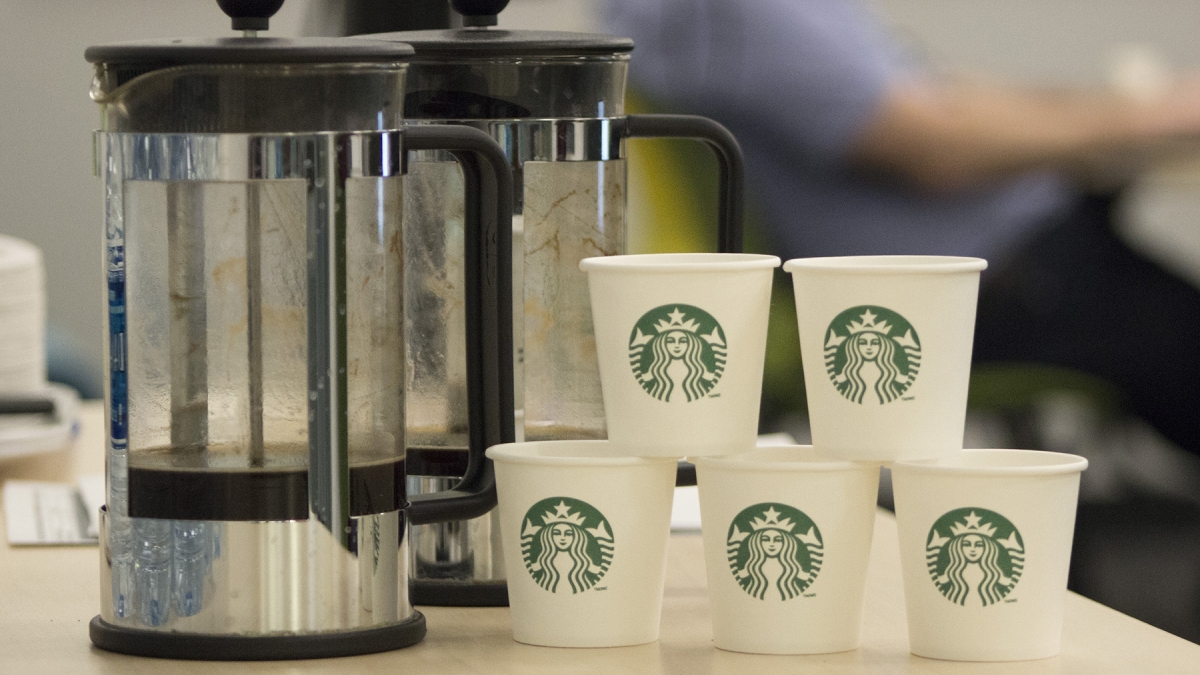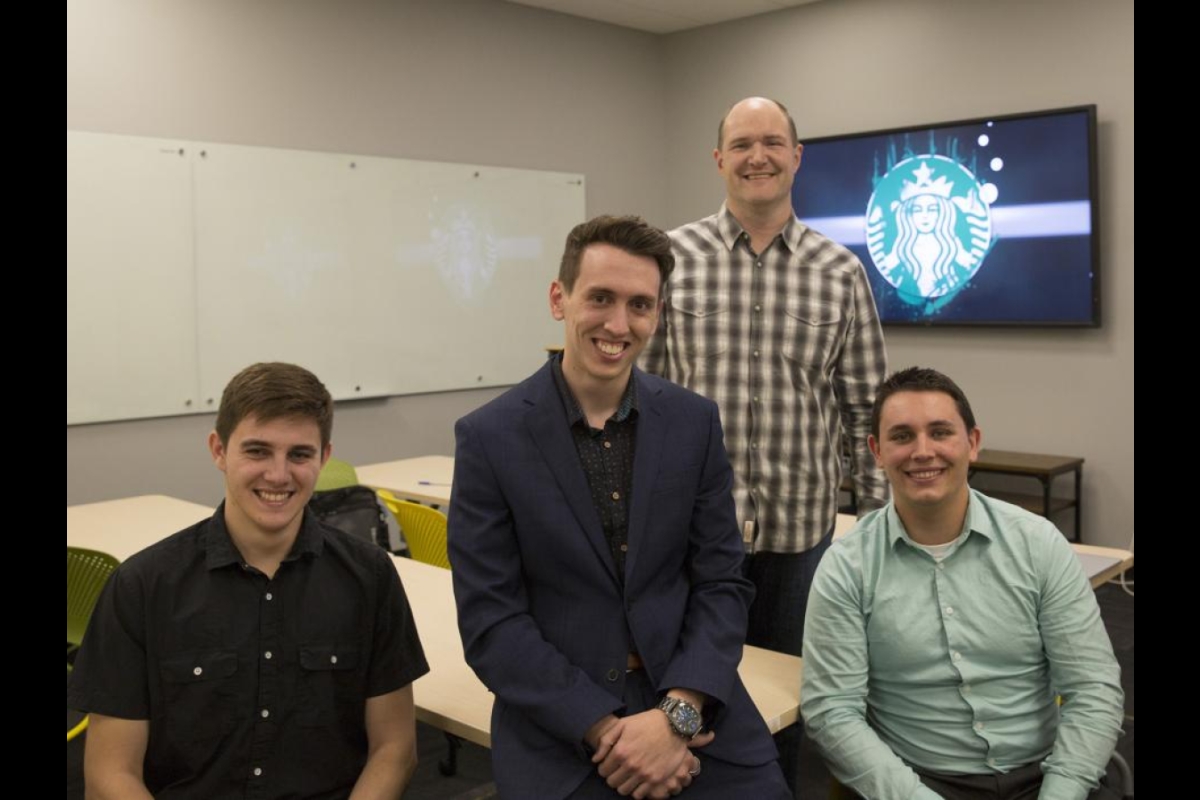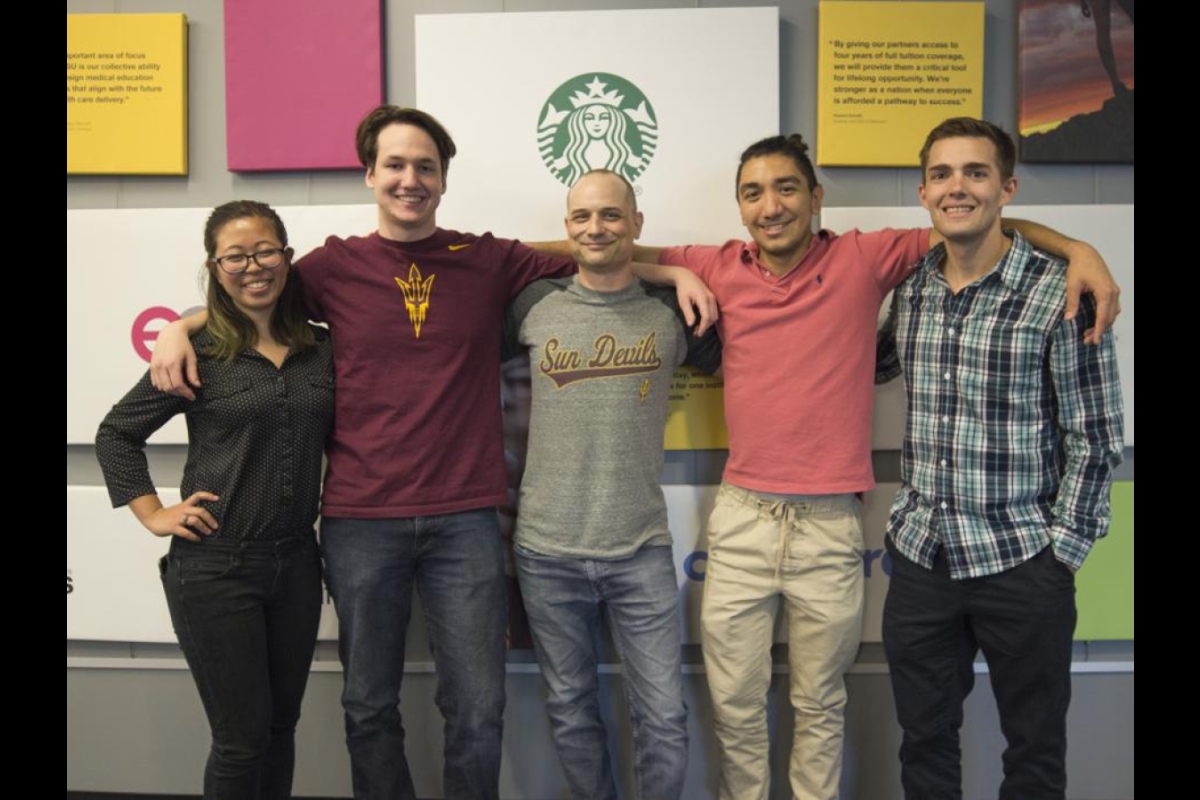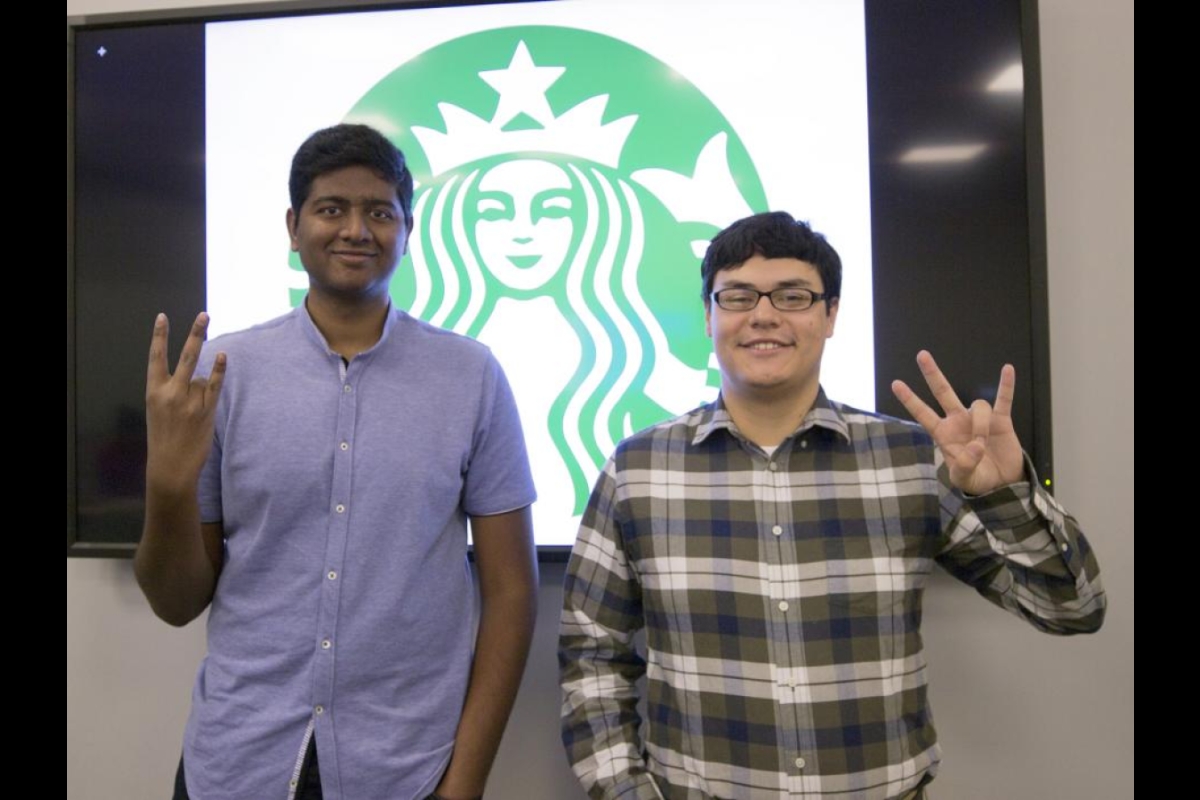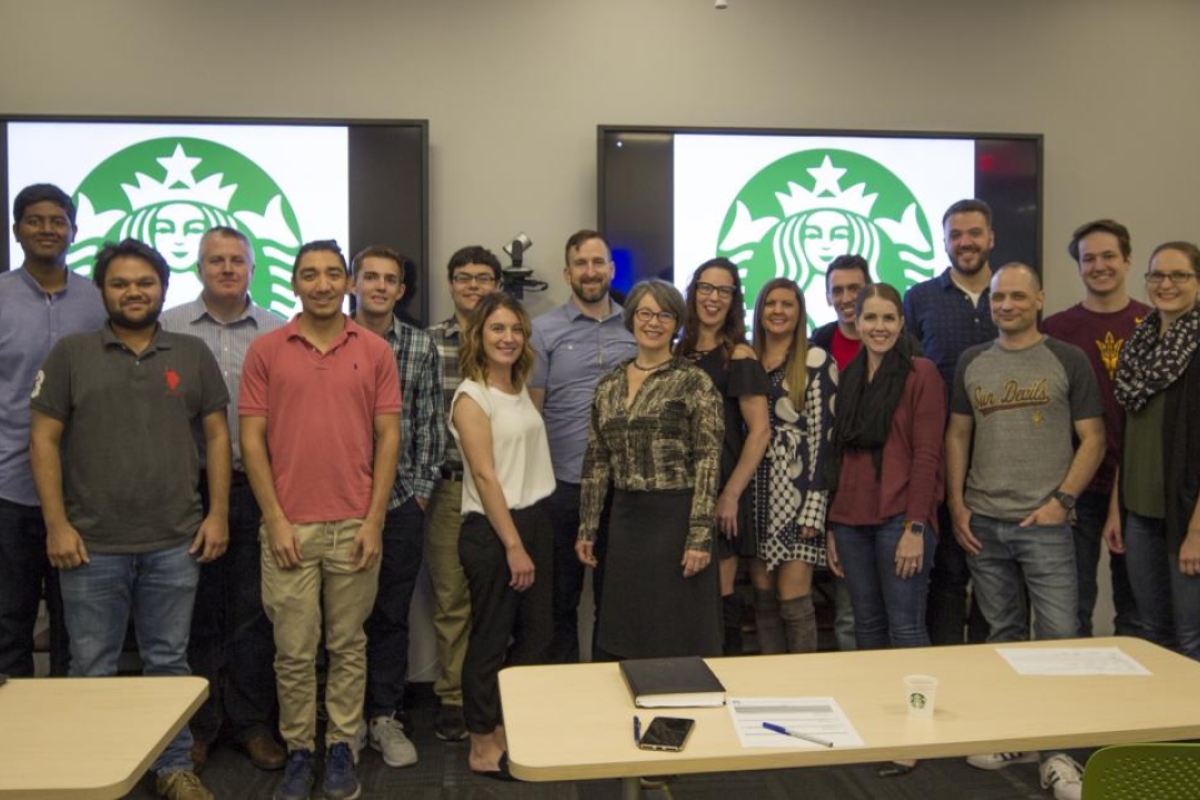For a team of 10 Arizona State University computer science and software engineering students, a Starbucks technology internship means considerably more than becoming a connoisseur of coffee — although that is part of the package. Being an intern at the new Starbucks Technology Center at ASU’s SkySong means an opportunity to get hands-on, real-world experience at one of the country’s top tech enterprises.
Starbucks, which built its reputation as a brick-and-mortar retailer, has become a leading force in digital engagement, providing consumers with seamless rewards, ordering and payment platforms supported by a state-of-the-art, enterprise-level “back end” that keeps it all running smoothly.
But staying on the consumer engagement edge requires finding partners, as Starbucks refers to its employees, who can lead digital innovation in the retail space.
The ASU students, who began as interns in September, have been working as teams in three technology areas: information security, application development and business intelligence.
“The Starbucks Technology Center was a natural next step in our evolving partnership with ASU; two organizations with common values around inclusivity, innovation, and excellence,” said Gerri Martin-Flickinger, Starbucks executive vice president and chief technology officer.
“Spending time with our STCStarbucks Technology Center interns and experiencing their compelling work firsthand, I am confident that we are achieving the goals that we set out to accomplish; bringing valuable experience and career opportunities to student interns while accelerating innovation and delivering exciting new experiences for Starbucks customers," Martin-Flickinger said. "I am proud to be a part of this team and look forward to our continued momentum in 2018.”
Information security
The information security team, comprised of computer science majors Anthony Pipia and Liam Lowrey, both seniors, and Caleb Schwartz, a junior, built a dashboard that details vulnerability across a range of systems, enabling data to be sorted by department rollup to determine instances of risk for specific teams, or the organization as a whole.
“In my last gig I felt like a lowly, part-time worker,” said Pipia, who is looking forward to continuing his partnership in the second half of his senior year.
“Starbucks is exactly the opposite — I feel like part of the big picture,” he said. “I have the opportunity to work in a collaborative environment with the team, whether we’re in different states or just down the hall, and constantly be engaged.”
Application development
The interns supporting digital products — computer science seniors Ross Carrigan and Diana Chen, computer science junior Michael Rojas and software engineering senior Aaron Musengo — worked on a variety of support projects for the Starbucks iOS app. A major project included improving the customer search function to return a more relevant list of items. The resulting app upgrade will deploy this month.
For Rojas, the importance and scope of work undertaken by the interns was surprising.
“I didn’t think they’d trust interns to become such integrated members of the technology team. Of course, they checked my code,” he said, laughing, “but I felt fully supported by the whole team.”
Rojas also identifies learning softer skills not taught in school as one of the biggest benefits of the internship.
“I’ve learned how to work with local and remote team members in an Agile framework on a daily basis, and have been able to see things in code that I learned in class," Rojas said. “I’ve never had the opportunity to work with a designer before — and now I’ve worked with one on a project from start to finish.”
Business intelligence
Avinash Reddy Kaitha, who graduated in December with a master’s degree in computer science; Tejinder Singh Kang, a computer science senior; and Kirtus Leyba, a computer science doctoral candidate, worked on adding and improving artificial intelligence and machine learning models across a variety of projects. This included wait time analysis predictions, outside temperature correlation to drink orders, and a chatbot interface that allows both customers and baristas to improve their experiences.
Working on information processing-recommender systems in depth required the team to develop a strategy on how to collect and integrate data.
“My number one takeaway is understanding what it takes to build a technology product from start to finish,” Kaitha said.
Impressed with the work environment, Kaitha said he’d love to do a stint in Starbucks corporate offices — a goal that has become a reality. He officially joins Starbucks as a full-time partner assigned to the Starbucks Technology Center this month.
In November, the teams participated in the Starbucks Innovation Expo (SiX) Hack Day project — one of a series of events in which Starbucks Innovation Technology partners can create and demonstrate concepts that improve the partner-customer experience. The interns built an app add-on feature that will allow customers to collect “You are Here” digital mugs when they make purchases in different cities, ultimately redeeming them for a physical mug. This project, one of 13 company-wide, won the Best Customer Facing Project Award.
“The moment I realized the team had really come together was during the Hack Day Project,” said Andy Scearce, program manager for mobile applications at the Starbucks Technology Center. “They were all sitting in one cubicle with their laptops talking through their ideas and working out the details. They were fully engaged, operating as an independent team on a single project. That’s what we’re looking for in this program — creating teams that can come together to both innovate and problem solve.”
Learning beyond technology
Chen said the Starbucks experience was enlightening because in a previous internship, technology was the product.
“With Starbucks, the product is retail that is supported by the technology. Unlike many technology-based enterprises, we have to be able to interact with partners on the retail side, not just the customers,” she explained. “The technology may be similar, but the communication processes are very different. That’s a valuable skill to take out into the workforce.”
And soon more ASU students will learn that skill.
“This spring we will be welcoming 12 more interns to the STC. With such impressive results in our first intern class, we are eager to see what the new cohort can achieve in their time with us,” said Jessica Gabry, Starbucks Technology Center program manager. “The ASU students create an organic environment of collaboration and innovation that is hard not to be inspired by.”
While giving end-of-semester project presentations for audiences both in Phoenix and in Seattle via live webcast, the interns commented on the value of the fully immersive internship, noting that at Starbucks, immersion extends beyond technology. In addition to short assignments working with retail teams at Starbucks stores, regular coffee tastings are designed to educate partners on Starbucks core product and build team relationships.
At the close of the end-of-semester presentations detailing their accomplishments, each intern cited his or her favorite Starbucks roast and beverage.
“The Starbucks Technology Center internships give our engineering students a direct path from college into the workforce, providing them with hands-on, in-the-field opportunities to enhance their skills at an international, corporate team level as well as on small-team projects,” said Kyle Squires, dean of ASU’s Ira A. Fulton Schools of Engineering. “Whether participants go on to become full Starbucks partners or move into other arenas, the opportunities generated by this program give them a competitive advantage as they enter the job market.”
More Science and technology

ASU-led space telescope is ready to fly
The Star Planet Activity Research CubeSat, or SPARCS, a small space telescope that will monitor the flares and sunspot activity of low-mass stars, has now passed its pre-shipment review by NASA.…

ASU at the heart of the state's revitalized microelectronics industry
A stronger local economy, more reliable technology, and a future where our computers and devices do the impossible: that’s the transformation ASU is driving through its microelectronics research…

Breakthrough copper alloy achieves unprecedented high-temperature performance
A team of researchers from Arizona State University, the U.S. Army Research Laboratory, Lehigh University and Louisiana State University has developed a groundbreaking high-temperature copper alloy…


